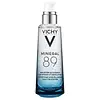What's inside
What's inside
 Key Ingredients
Key Ingredients

 Benefits
Benefits

 Concerns
Concerns

No concerns
 Ingredients Side-by-side
Ingredients Side-by-side

Dimethicone
EmollientDimethicone Crosspolymer
Emulsion StabilisingButylene Glycol
HumectantGlycerin
HumectantAlcohol Denat.
AntimicrobialSodium Ascorbyl Phosphate
AntioxidantPEG/PPG-18/18 Dimethicone
EmulsifyingMagnesium Sulfate
Phenoxyethanol
PreservativeCetyl PEG/PPG-10/1 Dimethicone
EmulsifyingPolyglyceryl-4 Isostearate
EmulsifyingHexyl Laurate
EmollientRetinyl Palmitate
Skin ConditioningHydrolyzed Rice Protein
Skin ConditioningPropylene Glycol
HumectantTocopheryl Acetate
AntioxidantSorbitan Laurate
EmulsifyingSalicylic Acid
MaskingMethylparaben
PreservativeEthylparaben
PreservativeCarbomer
Emulsion StabilisingMedicago Sativa Extract
TonicPolysorbate 20
EmulsifyingHydroxyethylcellulose
Emulsion StabilisingPanax Ginseng Root Extract
EmollientMorus Alba Leaf Extract
Skin ConditioningSodium Benzoate
MaskingAcetyl Dipeptide-1 Cetyl Ester
Skin ConditioningTocopherol
AntioxidantEthylhexylglycerin
Skin ConditioningPalmitoyl Oligopeptide
CleansingPalmitoyl Tetrapeptide-7
Skin ConditioningDimethicone, Dimethicone Crosspolymer, Butylene Glycol, Glycerin, Alcohol Denat., Sodium Ascorbyl Phosphate, PEG/PPG-18/18 Dimethicone, Magnesium Sulfate, Phenoxyethanol, Cetyl PEG/PPG-10/1 Dimethicone, Polyglyceryl-4 Isostearate, Hexyl Laurate, Retinyl Palmitate, Hydrolyzed Rice Protein, Propylene Glycol, Tocopheryl Acetate, Sorbitan Laurate, Salicylic Acid, Methylparaben, Ethylparaben, Carbomer, Medicago Sativa Extract, Polysorbate 20, Hydroxyethylcellulose, Panax Ginseng Root Extract, Morus Alba Leaf Extract, Sodium Benzoate, Acetyl Dipeptide-1 Cetyl Ester, Tocopherol, Ethylhexylglycerin, Palmitoyl Oligopeptide, Palmitoyl Tetrapeptide-7
 Reviews
Reviews

Ingredients Explained
These ingredients are found in both products.
Ingredients higher up in an ingredient list are typically present in a larger amount.
Butylene Glycol (or BG) is used within cosmetic products for a few different reasons:
Overall, Butylene Glycol is a safe and well-rounded ingredient that works well with other ingredients.
Though this ingredient works well with most skin types, some people with sensitive skin may experience a reaction such as allergic rashes, closed comedones, or itchiness.
Learn more about Butylene GlycolCarbomer is a polymer of acrylic acid. Its main role is to create a gel consistency.
A high amount of carbomer can cause pilling or balling up of products. Don't worry, most products contain 1% or less of carbomer.
Glycerin is already naturally found in your skin. It helps moisturize and protect your skin.
A study from 2016 found glycerin to be more effective as a humectant than AHAs and hyaluronic acid.
As a humectant, it helps the skin stay hydrated by pulling moisture to your skin. The low molecular weight of glycerin allows it to pull moisture into the deeper layers of your skin.
Hydrated skin improves your skin barrier; Your skin barrier helps protect against irritants and bacteria.
Glycerin has also been found to have antimicrobial and antiviral properties. Due to these properties, glycerin is often used in wound and burn treatments.
In cosmetics, glycerin is usually derived from plants such as soybean or palm. However, it can also be sourced from animals, such as tallow or animal fat.
This ingredient is organic, colorless, odorless, and non-toxic.
Glycerin is the name for this ingredient in American English. British English uses Glycerol/Glycerine.
Learn more about GlycerinPhenoxyethanol is a preservative that has germicide, antimicrobial, and aromatic properties. Studies show that phenoxyethanol can prevent microbial growth. By itself, it has a scent that is similar to that of a rose.
It's often used in formulations along with Caprylyl Glycol to preserve the shelf life of products.